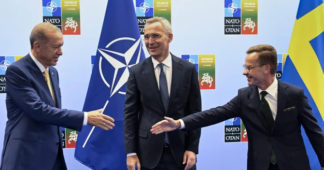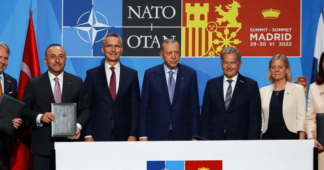Cross-posted from Michael Roberts’ blog
Jun 16, 2025
Debt distress across the global south and the mounting evidence of climate breakdown are major crises which are not even on the radar of the G7 and the Bilderberg group as they meet this week.
Michael Roberts is an Economist in the City of London and a prolific blogger.

As I write, the government leaders of the Group of Seven (G7) countries – Canada, France, Germany, Italy, Japan, the United Kingdom and the US – are meeting in the remote town of Kananaskis, Alberta, in the foothills of the Canadian Rockies, for intense discussions. This will be the 51st summit meeting of the top seven capitalist economies. The G7 still represents 44% of world’s GDP, but now only 10% of the world’s population. Yet the G7 and some of its smaller partners constitute the imperialist core, the so-called Global North, that rules the world.

What are the G7 leaders discussing? Naturally, it is the accelerating Middle East crisis after the Israeli attack on Iran; the continued war in Ukraine and the need for more sanctions on Russia and arms for Ukraine; what to do about Trump’s trade tariffs; how to impose a range of cuts in international aid to poor countries by most G7 governments in order to make room for increased arms spending; and the need for a common policy against China.
At the same time as the G7 meeting of governments, in Sweden, a bunch of tech billionaires, prime ministers, corporate titans and the king of the Netherlands have convened in Sweden for the 71st Bilderberg meeting at the swanky Grand hotel in Stockholm, owned by Sweden’d longstanding oligarchs, the Wallenberg family.

The Bilderberg group is a secretive conclave where the movers and shakers of world capitalism can discuss privately the strategies and policies needed to preserve the system, ie imperialism. At this meeting will be the heads of Nato and MI6, and two of America’s most senior military officers in the room along with the CEOs of several major ‘defence’ suppliers such as Palantir, Thales and Anduril. The host of the conference, Marcus Wallenberg, runs his own arms company, Sweden’s largest defence contractor, Saab.
The main discussion for the Bilberberg participants is how to strangle economically, politically and militarily, China. As the American MAGA Republican Jason Smith put it: he was in Sweden to “continue fighting to combat the economic and national security threat China poses to our great nation”. Fellow Bilderberg attendee Robert Lighthizer, economic adviser close to Trump, echoed that sentiment: “China to me is an existential threat to the United States”.
But here is the rub. There are two great issues that it seems neither the G7 leaders nor the Bilderberg bruisers will be discussing, obsessed as they are with the perceived geopolitical threats posed by the ‘resistant’ powers of Russia, Iran and China. There will be little or no discussion of the deteriorating economic landscape of the global economy, including the major economies of the Global North; nor will there be much discussion about the existential threat to economies and peoples from global warming and climate change. In the latter’s case, it is increasingly clear that governments and Bilderbergs have given up; they prefer to make profits in a fossil fuelled world while the going is good.
Yet these are the two issues that are likely to undermine all the efforts of the rulers of the Global North economies. The major economies are in increasingly deep trouble. This is made clear in the latest deeply dismal report from the World Bank on global economic prospects. As the report put it: “This year alone, our forecasts indicate the upheaval will slice nearly half a percentage point off the global GDP growth rate that had been expected at the start of the year, cutting it to 2.3 percent. That’s the weakest performance in 17 years, outside of outright global recessions… By 2027, global GDP growth is expected to average just 2.5 percent in the 2020s—the slowest pace of any decade since the 1960s.”
The World Bank makes the point that this slowdown is not new. “Growth in developing economies has now been ratcheting downward for three decades in a row—from an average of 5.9 percent in the 2000s to 5.1 percent in the 2010s to 3.7 percent in the 2020s. That happens to track the declining trajectory of growth in global trade—which has fallen from an average of 5.1 percent in the 2000s to 4.6 percent in the 2010s to 2.6 percent in the 2020s. Investment, meanwhile, has been growing at a progressively weaker pace. But debt is piling up.”
The World Bank goes on: “The poorest countries will suffer the most. By 2027, the per capita GDP of high-income economies will be roughly where it had been expected to be before the COVID-19 pandemic. (That’s not saying much – MR). But developing economies would be worse off, with per capita GDP levels 6 percent lower. Except for China, it could take these economies about two decades to recoup the economic losses of the 2020s.” In other words, far from the poorest countries making any progress in improving living standards for these most populated places, these countries are dropping further behind. Poverty rates (even those unrealistically set by the World Bank) are rising.

The OECD, the agency for the Global North economies, in a new report, echoes the World Bank’s depressing analysis. According the OECD’s latest economic outlook, the global economy is heading into its weakest growth spell since the Covid-19 slump. “Weakened economic prospects will be felt around the world, with almost no exception.” And that includes the leading imperialist power. The OECD forecasts that US growth will slow particularly sharply, from 2.8 per cent in 2024 to just 1.6 per cent in 2025 and 1.5 per cent in 2026, while US inflation is expected to rise to nearly 4 per cent by the end of 2025 and remain above the Fed’s target in 2026, meaning the US central bank will not cut rates to ease the debt burden on households and small companies.
Elsewhere, Chinese real GDP growth will slow from 5 per cent in 2024 to 4.7 per cent in 2025 (still some three times faster than the US) and 4.3 per cent in 2026, while the Eurozone will expand by just 1 per cent this year and 1.2 per cent in 2026. Japan’s economy will grow by just 0.7 per cent and 0.4 per cent this year and next respectively. The UK economy is predicted to expand by 1.3 per cent this year, but just 1 per cent in 2026. And all these forecasts exclude the long-term impact of Trump’s tariffs.

Global trade will expand by 2.8 per cent in 2025 and 2.2 per cent in 2026, sharply lower than OECD predictions in December. And fiscal risks are rising along with trade tensions, the OECD warned, with demands for more defence expenditure set to add to spending pressures.
Behind the slowdown in national output growth is the further weakening of productive investment growth.

Those readers who have followed my thesis of a long depression in the world capitalist economy for the last 18 years will recognise the ‘inverted square root’ trajectory of investment since 2008. After each crunch or crisis in accumulation (2008 and 2020), the major economies have not restored the previous rate of business investment growth.
The OECD sums it all up. “Historically elevated” equity valuations are increasing vulnerabilities to negative shocks in financial markets. A long spell of weak investment has compounded the longer-term challenges facing OECD economies, and this is further sapping the growth outlook.” Meanwhile, “despite rising profits, firms have shied away from fixed-capital investment in favour of accumulating financial assets and returning funds to shareholders.”
While the leaders and strategists of global capitalism meet in Canada and Sweden to discuss how to handle Russia, China and Iran, the immediate economic picture in their own economies is getting bleaker. According to the second estimate for the first quarter of 2025 US real GDP fell 0.2% compared to the last quarter of 2024. Most worrying, corporate profits fell 2.9% qoq, while non-financial corporate profits fell 3.5% on the quarter. Profits growth is slowing…

… and profit margins (sale price minus costs per unit) have now peaked.

The US economy is not yet in a recession but if company profits slow further or fall, then investment will eventually follow. JP Morgan economists warn of stagflation ahead for the US economy. Stagflation, a term from the 1970s, is when national output is stagnant, but inflation stays high and even rises – the opposite of Keynesian theory. JPMorgan equity strategists wrote: “After the recent rebound, we believe weakness will follow, which may resemble the stagflation period, during which trade negotiations are expected to conclude.” Consumer confidence has remained weak: “The past practice of placing orders in advance on the eve of tariff hikes may have paid off, but with purchasing power being squeezed, consumers’ purchasing power will weaken. Even with a significant pullback, the current tariff situation is worse than what most people expected at the beginning of the year.”

In JPMorgan’s view, higher input costs and interest expenses will erode profit margins and so corporate earnings growth for S&P 500 companies may drop sharply and the US economy will stagnate. This is something I predicted in a post last February, a whiff of stagflation.
And the economic activity indicators for the other major G7 economies show that they are already either stagnating or in recession. May’s Eurozone composite PMI indicated that both the services and manufacturing sectors of the region were contracting, the latter at its lowest in three years. The region’s contraction was led by France (now nine months of decline) and Germany (where the services sector dropped at its fastest pace in over two years). The UK also continued to contract, driven by a manufacturing sector at its lowest in 19 months.
So the situation for the Global North economies is worsening. But it is nothing to the unending distress of the poorest economies in the world, where the bulk of humanity tries to make a living. The debt burden (the ratio of debt to GDP owed to banks and governments around the world) for these countries continues to rise.

Total debt in the so-called emerging markets (EMs) excluding China rose by 3 percentage points of GDP in 2023 to reach 126 percent of GDP. Debt in low-income developing countries (LIDCs) also increased and is above pre-pandemic levels. Debt repayments are now greater than new inflows of credit and capital. In 2023, low- and middle-income countries (excluding China) experienced a net outflow to the private sector of $30bn on long-term debt — a major drain on development. The total debt servicing costs (principal plus interest payments) of all LMICs reached an all-time high of US$1.4 trillion in 2023. Excluding China, debt servicing costs climbed to a record of US$971 billion in 2023, an increase of 19.7 percent over the previous year and more than double the amounts seen a decade ago. Total external debt stock of the poor countries hit at an all-time high of 8.8 trillion in 2023, up 2.4 percent from the previous year.
The World Bank in its latest international debt report does not shirk the reality. World Bank chief economist Indermit Gill put it starkly: “Large ongoing debt service burdens, especially in the public component of debt, accompanied by the expected fiscal tightening, could force some LMICs to spend less on other priorities, including social safety nets and public investment in physical and human capital.” Gill continues: “A decade ago, in an era when private capital was gushing into developing economies, governments and development institutions figured it was exactly what was needed to turbocharge progress on poverty reduction and other development goals. “The good news is that, globally, there are ample savings, amounting to US$17 trillion, and liquidity is at historical highs,” read a key World Bank strategy document of the time. That proved to be a fantasy. Since 2022, foreign private creditors have extracted nearly US$141 billion more in debt service payments from public sector borrowers in developing economies than they disbursed in new financing. For two years in a row now, the external creditors of developing economies have been pulling out more than they have been putting in.”
Gill sums up the state of foreign ‘aid’ and credits from the Global North’s banks and investment bodies to the governments and private sector of the Global South. “It reflects a broken financing system.” In 2023, developing countries spent a record $1.4 trillion just to service their debt. That amounted to nearly 4 percent of their GDPs. Ballooning interest payments accounted for most of the increase in overall debt service payments, surging by more than a third to about US$406 billion.
Recent data from the UN’s trade and development body, UNCTAD, reveal that 54 countries spend over 10 percent of their tax revenues on interest payments alone. The average interest burden for developing countries, as a share of tax revenues, has almost doubled since 2011. More than 3.3bn people live in countries that now spend more on debt service than on health, and 2.1bn in countries that spend more on debt than on education.
Gill again: “The result, for many developing countries, has been a devastating diversion of resources away from areas critical for long-term growth and development such as health and education. The squeeze on the poorest and most vulnerable countries has been especially fierce… more than half these countries are either in debt distress or at high risk of it. No wonder that private creditors have been retreating…. It is easy to kick the can down the road, to provide these countries just enough financing to help them meet their immediate repayment obligations. But that simply extends their purgatory.”
Gill: “These countries will need to grow at a faster clip if they are to shrink their debt burdens—and they will need much more investment if growth is to accelerate. Neither is likely, given the size of their debt burdens: their ability to repay will never be restored. It’s time to face the reality: the poorest countries facing debt distress need debt relief if they are to have a shot at lasting prosperity.” But no ‘debt relief’ is on the agenda of the Rockies or Bilderberg.
And then there is global warming and climate change. Global warming is accelerating. New climate predictions have found a 70% chance that global temperatures will exceed 1.5C above pre-industrial levels as average over the next five years. And there is an 80% chance that at least one year between 2025 and 2029 will set a new record for global temperatures, the analysis shows. And for the first time, climate models have shown there is a possibility that the world’s global average temperature could exceed 2C above pre-industrial levels before 2030.
US president Trump may consider that climate change is a myth. The World Bank does not think so. The World Bank warns of a climate emergency for 1.8 billion people in South Asia as the heat crisis looms. It has issued a stark warning on the growing threat of extreme heat in South Asia, projecting that nearly 1.8 billion people, roughly 89% of the region’s population, will be exposed to dangerous temperatures by 2030. “In 2021 alone, countries like Bangladesh, India, Pakistan, and Sri Lanka saw average daily conditions that were too hot for safe outdoor work for about six hours,” the report noted. That figure is expected to rise to seven or eight hours a day by 2050, threatening both livelihoods and health. According to the World Bank, over 60% of households and firms in the region have experienced extreme weather in the past five years and more than 75% expect such events to increase in the next decade.

A significant economic slowdown into stagnation, alongside still relatively high inflation; a crippling debt burden for the majority of the world’s population eking out a bare living; and an accelerating climate crisis – none of these issues will be discussed in the Rockies or in the Grand Hotel in Stockholm.
We remind our readers that publication of articles on our site does not mean that we agree with what is written. Our policy is to publish anything which we consider of interest, so as to assist our readers in forming their opinions. Sometimes we even publish articles with which we totally disagree, since we believe it is important for our readers to be informed on as wide a spectrum of views as possible.











